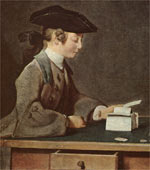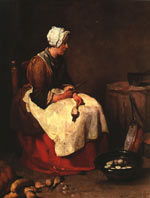
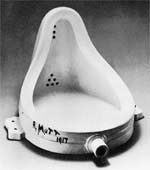
Marcel
Duchamp
Last November there was an extraordinary sale at Sotheby's. Somebody bought
a urinal. And they paid 1 million seven hundred thousand dollars for it.
It is a simple
white ceramic urinal, and what is special about it is that it was purchased
in 1917 by the French artist Marcel Duchamp.
He was at the
time head of the American Society of Independent Artists, who had declared
that as long as someone paid the fee of $6 dollars, their artistic
work would be
displayed. The directors however, drew the line at urinals and rejected
the piece. Duchamp resigned.
The Pompidou Centre
is running a Duchamp exhibition until June the 5th.
There is something
of a problem with the exhibition, though. Duchamp was trying to put forward
the idea of anti-retinal art, which must not be looked at in the aesthetic
sense. The exhibition
includes many of his notes, and perhaps this is just a case of art as
homework, which is a shame. It is not all that well attended and has been
taken rather too seriously for so humorous a man.
Jean-Baptiste-Siméon
-Siméon Chardin (1699-1779)
Chardin was an
artist, but his is not a household name.
But among the
impressionists, and among modern painters - most especially Lucien Freud,
Chardin's reputation could not be at a higher peak. The show is
supposed to commemorate the 300th anniversary of Chardin's birth, although
he was born in 1699. Well, who's counting.
Chardin painted
portraits, still-lifes and contemporary interior scenes with an exceptional
intensity of emotion and harmony of colour and composition, and no less
a commentator than Diderot called him, The Magician.
Jean-Siméon Chardin,the
'painter of silent life' might be pleased now to see the extent to which
the magic endures. In his portraits of objects and people, Chardin
is thought by many to have no equal. Lucien Freud
has actually been given special permission to revisit Chardin's
work for as many nights as he wants or needs after the crowds have departed.
The fact that Freud has gone back to Chardin's work again and again, to
study and to learn, is just one indication of the genius of Chardin.
Shebang went to view the hugely popular Art Nouveau Exhibition at the Victoria and Albert Museum in London, which rightly pays tribute to two important Belgian figures, the architect Victor Horta and the architect/designer Henry Van de Velde.
The real purpose
of the visit to the exhibition, though was to talk to Joel Primack
and his wife Nancy Abrams. Primack is a physics professor at the
University of Southern California at
Santa Cruz.He is currently refining new insights he has gained about the
nature of light in the universe.
Primack and Abrams
talked about a book they are working on, and a course they teach together:
Cosmology and Culture.
Nancy Abrams told Shebang: "Every culture known to anthropology
has had a shared picture of the universe, illustrated by stories of how
things came to be and how humans
fit into the greater scheme. Since the rise of modern science, however,
the West has lost this shared picture. There is no shared sense of what
our universe is - or the place of humanity in it - because most educated
people are unsatisfied by the old myths. Helped by technologies that allow
cosmologists to see back almost to the Big Bang, science is creating for
the first time an origin story that might actually be true.'
When Ms. Abrams
teaches, she uses examples from ancient civilisations as well as from
Medieval Europe. She shows how a culture’s picture of the universe is
intimately bound up with its religion and social institutions, and how
a new cosmology might affect our own society. The
couple have also taught children, in a class they call What Every Child
Needs to Know About the Universe. In it they explain that the universe
is really old - by their reckoning about 15 billion years old. It is growing
and is very different now from what it used to be. Different laws of nature
are important on different size scales.
It is a cherished notion of Primack's that humans are intermediate in
size, between the smallest and largest size scales, and the universe has
to be old and large to have intelligent creatures like us in it. In the
first half of the twenty-first century as the new picture is absorbed
into the larger culture, their ideas on Cosmology and Culture provide
an introduction to modern scientific cosmology. They also offer an examination,
through the study of earlier cosmologies, of the connection between how
people view the universe and how their surrounding culture reflects and
interprets it.
As Primack puts it, 'Scientific cosmology is today developing a new picture of the expanding universe that will possibly have a major impact over the coming decades as it is absorbed into our culture. Modern society has failed to develop a unified view of cosmology. The lack of social consensus on cosmology in the modern world has caused many people to close off their thinking to large issues and long time scales. But this need not be. The science of cosmology is experiencing a golden age of discovery and is poised to deliver a revolutionary description of the nature and origin of the universe.
'In the closing
years of the 20th century, we're learning enough to begin to peer across
the gulf that separates our universe from its source at the beginning
of, or perhaps
before, the Big Bang. A story is emerging in modern cosmology that will,
if it follows the pattern of earlier shifts in cosmology, change
our culture in
ways no one can yet predict.'
Primack adds that this new model of the cosmos has the potential to serve
as a source of inspiration and positive change in our society. The challenge
lies in making a complicated and counterintuitive scientific model of
the cosmos accessible to society at large.
To this end,
Primack resurrected an ancient symbol and used it to embody an image
of the cosmos
consistent with what scientists understand about the universe today.
That symbol, known
to the ancient Greeks as a "uroboros," is the snake swallowing its tail.
[Originally suggested by Harvard physicist and Nobel laureate Sheldon
Glashow }
The uroboros
represent the universe as a continuity of vastly different size scales,
with the swallowing of the tail representing the hoped-for unification
of theories governing the largest and smallest scales.
The
size scales in the known universe encompass about 60 orders of magnitude,
from the vastness of the cosmic horizon to the subatomic Planck scale,
the smallest size allowed by relativity and quantum physics. Yet people
asked to visualize "the universe" tend to think of endless space and uncountable
stars and galaxies, while the human scale shrinks into insignificance.
In fact, if all the size scales are laid out logarithmically on the cosmic
uroboros, the human scale is right smack in the middle between the head
and the tail of the snake.
Primack notes. 'Largeness is by no means the most important characteristic
of the universe. Focusing on it makes people feel small, not because they
are, but because they are simply ignoring all scales smaller than themselves.'
Michel Thomas
promises to be able to give anyone a working knowledge of a foreign language
in just a few days. Thomas is now in his eighties, and has been teaching
for 50 years. It's just that at his two exclusive schools, his students
have tended to be at the Woody Allen, Doris Day, Warren Beatty,
and Bob Dylan end
of the economic spectrum. He has finally agreed to make CD's and cassettes
of his magical method. Students
have paid tribute to Thomas's technique, which removes all anxiety, all
stress, and proceeds in a conversational way which appears random but
which very soon sees to it that the student is building simple phrases
and then sentences. He relates the structure of the sentences back to
the constructions of the language the pupils already know. He doesn't
say so, but he is teaching grammar, and is stripping away the inessentials.
He seems somehow to have condensed the way a child learns.
Thomas began by studying as Psychology at the Sorbonne in Paris, and was
deeply affected by a lecturer's statement: 'No-one knows about the learning
process of the
human mind.'
He settled in America after the war, and decided to investigate how human
beings learn. He used the learning of a foreign language as his medium
of investigation, because students begin by knowing nothing and because
progress is easy to measure.
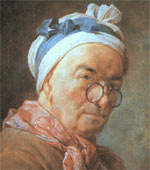
Chardin, self-portrait
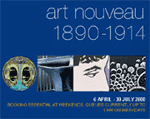
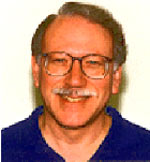
Joel Primack
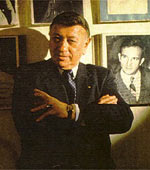
Michael Thomas

Marcel Duchamp
photo by Man Ray
